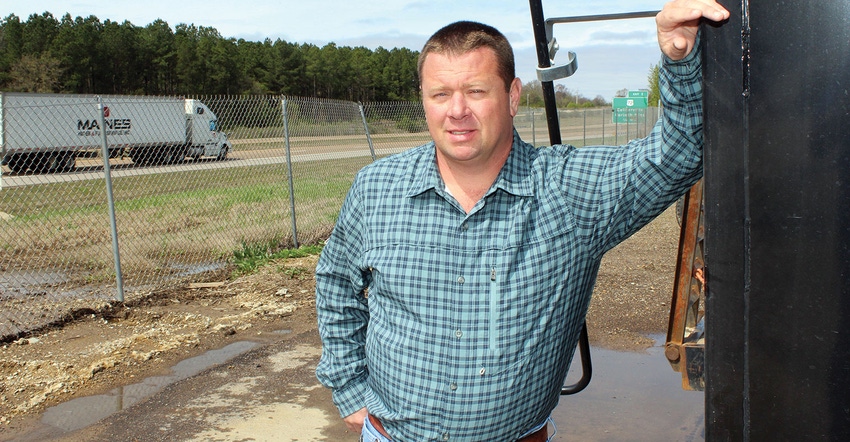April 9, 2020

Bruce and Charlie Yancey have learned to deal with losing farmland to urban encroachment, but that's not the biggest problem they face farming in an urban growth corridor.
The brothers, under Yancey Farming Partnership, farm cotton and soybeans along the Tennessee/Mississippi state line near Collierville, Tenn.
Production practices that would be routine in a more rural setting demand extra precautions in urban areas, they say. Moving equipment takes more planning. Varying road widths, overpass height limits, highway road signs and telephone pole wires pose challenges more frequently than in rural areas.
They have two on-board module harvesters and other large equipment. "Moving production equipment to and from our various farms in city traffic is dangerous," Yancey says. "If we finish harvesting one field at the beginning of a high-traffic period, we usually have to wait before moving equipment to the next farm. Sometimes it slows our production schedule, but we deal with it."
They take other in-season precautions. "Aerial application is not an option because of proximity to houses and/or restrictions to airspace. We often have to wait for low-wind conditions to make insecticide or herbicide applications," Yancey says.
They can protect cotton and soybeans from most pests. "Our biggest pest problem comes from pests with antlers," Yancey says. "Urban growth continues to push deer into the small patches of woods surrounding the fields we farm."
Deprivation permits issued through the Tennessee Wildlife Resources Agency (TWRA) are an option. "If deer damage 10 percent of a farmer's crop, he can apply for the permit as a control option," says Amy Spencer, outreach communications, TWRA. "All regulations and specifications must be followed under issuance of the permit."
Retaining acreage poses other problems. They often lose farmland to development.
"Most years we lose one or two farms to some type of commercial and/or residential real estate development," Yancey says. "Landlords wanting to keep their ground in the 'green belt' drives much of this land toward farming. Taxes on farmland are almost zero compared to land zoned for commercial development."
Yancey estimates land they farm east of Memphis to be valued around $3,000 an acre. "If a developer bids on that same ground, it could command upwards of $100,000 an acre," Yancey says. "Warehouses now stand on land we farmed just two years ago."
Pros and cons
Farms losing land to urban sprawl is a national issue.
Fourth generation farmer Kevin Rogers, Rogers Brothers Farm, Laveen, Ariz., has dealt with urban encroachment from the neighboring town of Phoenix his entire career. Rogers attended this year's Farm Press High Cotton Awards in support of his friend, Greg Wuertz, another Arizona farmer. He spoke with Farm Press about urban encroachment problems he faces.
"Farming next to any city is like farming under a microscope," he says. "Some of our farms are next to interstate systems and we receive calls many times because people don't understand agriculture."
Urban encroachment can increase farming costs. "We finally decided to purchase additional equipment rather than move it 20 miles to our farm on the other side of the city," Rogers says. "We've had environmental complaints because of dust when we pull equipment across fields or track out dirt on roads from trucks or equipment."
Rogers farms in a mature irrigation district and enjoys lower water costs. "That's one pro that helps keep us in business," Rogers says. "We deal with the urban encroachment by communicating what we do as a farm through social media and the press. I believe telling our story has helped lessen the impact on the urban population to an extent."
As cities continue to encroach on farms, natural resources used to produce food are being diverted to sustain population growth.
Population growth versus crop output
Leon Kolandiewicz, environmental and natural resources planner for the natural resources and conservation organization Numbers USA, says it is an inherent law of nature that land sought for commercial and residential real estate development, and land needed for farming share common characteristics. "These lands tend to be flatter, or more level, and near reliable sources of water," he says. "Development is eating up agricultural land, and population growth isn't helping."
A 2014 national study in which Kolandiewicz collaborated found each person added to the U.S. population leads to a third of an acre lost to development. "If 3 million people are added to our country every year, that equates to 1 million acres of lost rural or agricultural land annually," Kolandiewicz says.
"There has been great progress the last century increasing crop output, or yields, but can those increases sustain the demand from an increasing population as farmland continues to be lost?"
About the Author(s)
You May Also Like






